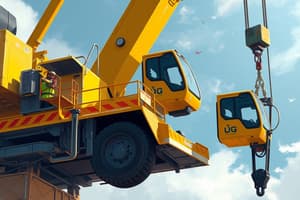Podcast
Questions and Answers
What are the three basic methods used to verify the hardness of lifting equipment?
What are the three basic methods used to verify the hardness of lifting equipment?
- Vickers, Charpy and Izod
- Vickers, Brinell and Rockwell (correct)
- Charpy, Izod and Rockwell
- Brinell, Charpy and Izod
Which hardness test is commonly used in the lifting equipment industry by manufacturers?
Which hardness test is commonly used in the lifting equipment industry by manufacturers?
- Vickers
- Brinell (correct)
- Rockwell
- Charpy
What is the primary purpose of the Charpy impact test?
What is the primary purpose of the Charpy impact test?
- To test the bending strength of the material
- To measure the amount of energy absorbed by a material during fracture (correct)
- To check the ductility of the material
- To determine the hardness of the material
What does the height of the pendulum swing measure in the Charpy impact test?
What does the height of the pendulum swing measure in the Charpy impact test?
Which of the following is NOT a characteristic of the Izod impact test?
Which of the following is NOT a characteristic of the Izod impact test?
What is the primary function of the bend test?
What is the primary function of the bend test?
What is a key difference between the Charpy and Izod impact tests?
What is a key difference between the Charpy and Izod impact tests?
Why are specimens notched in the Izod impact test?
Why are specimens notched in the Izod impact test?
What is the mode factor for a 2 leg sling assembly with an included angle of 90°?
What is the mode factor for a 2 leg sling assembly with an included angle of 90°?
What is the maximum load that a 3 leg sling assembly with a WLL of 1.5t can lift at an angle of 30° to the vertical?
What is the maximum load that a 3 leg sling assembly with a WLL of 1.5t can lift at an angle of 30° to the vertical?
What is the maximum load that a single leg sling with a WLL of 5t can lift when used as part of a 2 leg assembly at an angle of 45° to the vertical?
What is the maximum load that a single leg sling with a WLL of 5t can lift when used as part of a 2 leg assembly at an angle of 45° to the vertical?
What type of method uses the cosine of the angle to the vertical to calculate the mode factor?
What type of method uses the cosine of the angle to the vertical to calculate the mode factor?
Two identical single leg slings with a WLL of 1t are used together to lift a load. What is the maximum load the assembly can lift if the included angle is 45°?
Two identical single leg slings with a WLL of 1t are used together to lift a load. What is the maximum load the assembly can lift if the included angle is 45°?
What is the working load limit (WLL) of a two-leg sling with an included angle of 110°?
What is the working load limit (WLL) of a two-leg sling with an included angle of 110°?
What is the WLL of a four-leg sling with an included angle of 30°?
What is the WLL of a four-leg sling with an included angle of 30°?
Compared to a three-leg sling of the same size and grade, how is a four-leg sling rated in standards where the uniform load method is used?
Compared to a three-leg sling of the same size and grade, how is a four-leg sling rated in standards where the uniform load method is used?
What is a potential safety hazard when working with a three-leg sling at greater than 90° included angle?
What is a potential safety hazard when working with a three-leg sling at greater than 90° included angle?
What is the working load limit (WLL) of a multi-leg sling with more than two legs in Australia?
What is the working load limit (WLL) of a multi-leg sling with more than two legs in Australia?
Which of the following statements is TRUE about the WLL of a two-leg sling?
Which of the following statements is TRUE about the WLL of a two-leg sling?
What is the primary reason for using different WLLs based on the number of legs and included angle?
What is the primary reason for using different WLLs based on the number of legs and included angle?
When is it safe to assume a four-leg sling has a higher WLL than a three-leg sling of the same size and grade?
When is it safe to assume a four-leg sling has a higher WLL than a three-leg sling of the same size and grade?
What is the main reason why some manufacturers continue to use the trigonometric method for rating multipurpose slings?
What is the main reason why some manufacturers continue to use the trigonometric method for rating multipurpose slings?
What is the recommended method of rating slings for multipurpose use?
What is the recommended method of rating slings for multipurpose use?
Which of the following is NOT an advantage of the uniform load method for rating slings?
Which of the following is NOT an advantage of the uniform load method for rating slings?
What is the working load limit of a three-leg sling when the working load limit of a single leg is $W$ and the angle between the legs and the load is β?
What is the working load limit of a three-leg sling when the working load limit of a single leg is $W$ and the angle between the legs and the load is β?
How is the safe working load of a multi-leg sling affected if it is used with fewer legs than its actual capacity?
How is the safe working load of a multi-leg sling affected if it is used with fewer legs than its actual capacity?
When using multi-leg slings, which factor is crucial for determining the sling's safe working load?
When using multi-leg slings, which factor is crucial for determining the sling's safe working load?
Why is the uniform load method particularly advantageous when used with eyebolts in pairs?
Why is the uniform load method particularly advantageous when used with eyebolts in pairs?
What is the main reason why many national and international standards have adopted the uniform load method?
What is the main reason why many national and international standards have adopted the uniform load method?
What is the equivalent of 1 metric tonne (t) in kilograms (kg)?
What is the equivalent of 1 metric tonne (t) in kilograms (kg)?
How many pounds (lbs) are in one Imperial Ton?
How many pounds (lbs) are in one Imperial Ton?
What is the symbol for a hundredweight?
What is the symbol for a hundredweight?
What is the equivalent of 1 Imperial Ton in kilograms?
What is the equivalent of 1 Imperial Ton in kilograms?
What is the equivalent of 1 US Ton in kilograms?
What is the equivalent of 1 US Ton in kilograms?
How many kilograms (kg) are in one hundredweight (cwt)?
How many kilograms (kg) are in one hundredweight (cwt)?
Which symbol represents the Imperial or US Ton?
Which symbol represents the Imperial or US Ton?
Based on the provided content, what is the relationship between a hundredweight and an Imperial Ton?
Based on the provided content, what is the relationship between a hundredweight and an Imperial Ton?
What is the purpose of conducting a bend test on welds?
What is the purpose of conducting a bend test on welds?
In what material is a bending test primarily used for?
In what material is a bending test primarily used for?
What is the primary consideration when stamping marking directly into lifting equipment?
What is the primary consideration when stamping marking directly into lifting equipment?
When is it recommended to re-mark lifting equipment?
When is it recommended to re-mark lifting equipment?
What is the primary concern regarding the use of multi-leg slings at angles?
What is the primary concern regarding the use of multi-leg slings at angles?
What is the relationship between the angle of the sling legs and the load in each leg?
What is the relationship between the angle of the sling legs and the load in each leg?
What is the primary purpose of marking lifting equipment?
What is the primary purpose of marking lifting equipment?
What are the two methods mentioned for calculating load distribution in multi-leg slings?
What are the two methods mentioned for calculating load distribution in multi-leg slings?
Flashcards
Unit of Measure
Unit of Measure
A standardized quantity of a physical property.
International System of Units (SI)
International System of Units (SI)
The most widely used system of units, consisting of seven base units.
Base Units in SI
Base Units in SI
There are seven fundamental units in the SI system.
Ton (US)
Ton (US)
Signup and view all the flashcards
Tonne (Metric)
Tonne (Metric)
Signup and view all the flashcards
Imperial Ton
Imperial Ton
Signup and view all the flashcards
Hundredweight (cwt)
Hundredweight (cwt)
Signup and view all the flashcards
Weight Conversion
Weight Conversion
Signup and view all the flashcards
Bend Test
Bend Test
Signup and view all the flashcards
Purpose of Bend Testing Welds
Purpose of Bend Testing Welds
Signup and view all the flashcards
Marking Lifting Equipment
Marking Lifting Equipment
Signup and view all the flashcards
Suitable Marking Means
Suitable Marking Means
Signup and view all the flashcards
Re-marking Equipment
Re-marking Equipment
Signup and view all the flashcards
Trigonometry of Slinging
Trigonometry of Slinging
Signup and view all the flashcards
Multi-leg Sling
Multi-leg Sling
Signup and view all the flashcards
Effect of Angles on Sling Load
Effect of Angles on Sling Load
Signup and view all the flashcards
Hardness Test
Hardness Test
Signup and view all the flashcards
Brinell Test
Brinell Test
Signup and view all the flashcards
Impact Test
Impact Test
Signup and view all the flashcards
Charpy Impact Test
Charpy Impact Test
Signup and view all the flashcards
Izod Impact Test
Izod Impact Test
Signup and view all the flashcards
Notch Toughness
Notch Toughness
Signup and view all the flashcards
Shock Loading
Shock Loading
Signup and view all the flashcards
Single Leg Sling WLL
Single Leg Sling WLL
Signup and view all the flashcards
Two Leg Sling (0-45°) WLL
Two Leg Sling (0-45°) WLL
Signup and view all the flashcards
Two Leg Sling (45-60°) WLL
Two Leg Sling (45-60°) WLL
Signup and view all the flashcards
Three/Four Leg Sling (0-45°) WLL
Three/Four Leg Sling (0-45°) WLL
Signup and view all the flashcards
Three/Four Leg Sling (45-60°) WLL
Three/Four Leg Sling (45-60°) WLL
Signup and view all the flashcards
Multipurpose Four-leg Sling
Multipurpose Four-leg Sling
Signup and view all the flashcards
Two-Leg Sling Standard in Australia
Two-Leg Sling Standard in Australia
Signup and view all the flashcards
Included Angle Misunderstanding
Included Angle Misunderstanding
Signup and view all the flashcards
Mode Factor
Mode Factor
Signup and view all the flashcards
Working Load Limit (WLL)
Working Load Limit (WLL)
Signup and view all the flashcards
Sling Angle Effect
Sling Angle Effect
Signup and view all the flashcards
Design Factors for Slings
Design Factors for Slings
Signup and view all the flashcards
2 Leg Sling 0°-45° WLL Factor
2 Leg Sling 0°-45° WLL Factor
Signup and view all the flashcards
3/4 Leg Sling 0°-45° WLL Factor
3/4 Leg Sling 0°-45° WLL Factor
Signup and view all the flashcards
Calculating Maximum Load with Slings
Calculating Maximum Load with Slings
Signup and view all the flashcards
Trigonometric Method for Sling Load
Trigonometric Method for Sling Load
Signup and view all the flashcards
Uniform Load Method
Uniform Load Method
Signup and view all the flashcards
Trigonometric Method
Trigonometric Method
Signup and view all the flashcards
Single Leg Sling WLL Calculation
Single Leg Sling WLL Calculation
Signup and view all the flashcards
Two Leg Sling WLL Calculation
Two Leg Sling WLL Calculation
Signup and view all the flashcards
Three Leg Sling WLL Calculation
Three Leg Sling WLL Calculation
Signup and view all the flashcards
Multi-Leg Sling Usage
Multi-Leg Sling Usage
Signup and view all the flashcards
Safety and Simplicity Standards
Safety and Simplicity Standards
Signup and view all the flashcards
Study Notes
Units of Measure
- A unit of measure is a standardized quantity of a physical property used to determine multiple quantities of the same property.
- Examples include weight, length, mass, and force.
- Different systems of units are based on fundamental units.
- The International System of Units (SI) is the most widely used system, with seven base units.
- Other SI units can be derived from these base units.
- When marking lifting equipment using the SI system, fractions of a tonne (e.g., 2.1t) are typically marked with one decimal place except for 0.25, which is marked using two decimal places (e.g., 2.25t).
Symbols and Conversions
- Ton (US): T = Imperial/US Ton = 2,000 lbs = 907.185 kg
- Ton (metric): t = metric tonne = 1,000 kg = 2,204.62 lbs
- Ton (Imperial): 1 Ton (imperial) = 1,016 kg = 2,239.9lbs
- Hundredweight (cwt): 1 cwt = 50 kg
Other Useful Conversions
- 1 kg = 2.2 lbs
- 1 inch = 25.4 mm
- 1 foot = 12 inches
- 10 kN = 1,000 kg (approximately)
Test Machines and Force/Load Measuring Equipment
- Accuracy is essential when applying load or force, as stipulated by many product standards and codes of practice.
- The LEEA Technical Requirements for Members and Guidance document lists the accuracy requirements and intervals for calibrating test machines and load cells as per ISO7500-1.
- ISO7500-1 has various classes/grades of machines relating directly to accuracy (e.g., Grade 0.5 = ±0.5%, 1.0 = ±1%, 2.0 = ±2%).
- Calibration certificates specify the Lower Limit of Calibration (load/force) below which accurate values cannot be measured.
Dimensional Measuring Equipment
- The most basic equipment used for lifting equipment verification is graduated to national standards in 1mm increments.
- More precise equipment, such as a Vernier gauge (0.1 mm graduation), may be needed for certain items.
Crack Detection
- For general lifting equipment, basic crack detection (dye penetration or magnetic particle) is common.
- Trained operatives perform and interpret the results.
- More detailed crack detection methods (eddy current, radiography, ultrasonic) are used for high-value items with stringent safety requirements.
Dye Penetrant, Magnetic Particle, Eddy Current, and Radiography
- Different methods for detecting surface cracks/defects in materials
- Dye penetrant: detects surface breaks in nonporous material
- Magnetic particle (MPI): detects surface cracks in ferrous/magnetic materials
- Eddy current: detects surface and subsurface anomalies in conductive materials
- Radiography: detects internal and surface defects using radiation
Ultrasonic
- High-frequency sound waves used to detect cracks in a material.
- Speed, reliability, and versatility
Electromagnetic Wire Rope Examination
- Fast method for detecting defects in long wire ropes using magnetic flux and leakage methods
Hardness (Vickers, Brinell, Rockwell)
- Indentations used for verification of lifting equipment hardness.
- Measurement of material's resistance to indentation
- Brinell is the most common method in the lifting equipment industry.
Impact Tests (Charpy, Izod)
- Measures energy absorbed by a material during fracture to determine its notch toughness.
- Identifies a material's properties when experiencing shock loading.
- Used to evaluate weld quality, identifying potential defects or weaknesses.
Marking Lifting Equipment
- Equipment should be marked permanently (e.g., plates, metal tabs, labels) in an appropriate, non-load-bearing location.
- Marking should conform to relevant standards for location, size, and information conveyed.
Trigonometry of Slinging
- Multi-leg slings at angles increase load in individual legs according to trigonometry.
- Best practice is to measure the angle between the sling leg and the vertical
- Included angles, angles to the vertical, and angles to the horizontal may be used
Uniform Load Method
- Simpler rating method used for multi-leg slings and is easier to calculate.
- Rating based on included angle and leg count/single leg WLL
- Recommended for multipurpose slings
- Multi-purpose 4-leg sling rated same WLL as 3-legged sling (assuming 3 legs carry the load).
Trigonometric Method
- Accounts for varying angle to vertical.
- Sling capacity depends on the angle between the lifting sling legs and the vertical.
- Operative must calculate angle and adjust rating accordingly for all multiple-leg sling scenarios.
- Uniform Load Method is often used for simplicity but the trigonometric method may be used for unique purposes.
Multi-leg Sling User Information
- Rating reduced if fewer legs are used to lift the load.
- Reduced rating is based on the actual number of legs used to perform the lift.
Studying That Suits You
Use AI to generate personalized quizzes and flashcards to suit your learning preferences.




